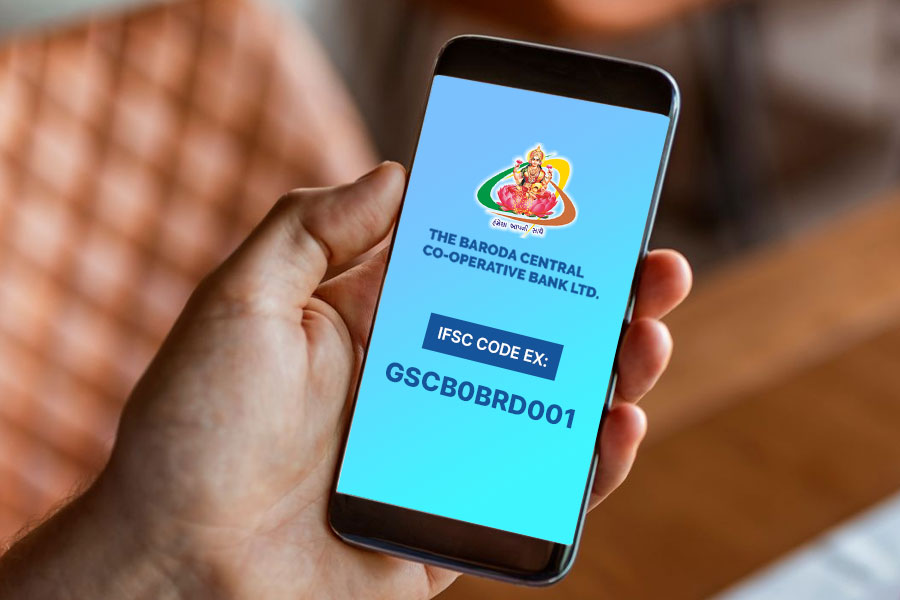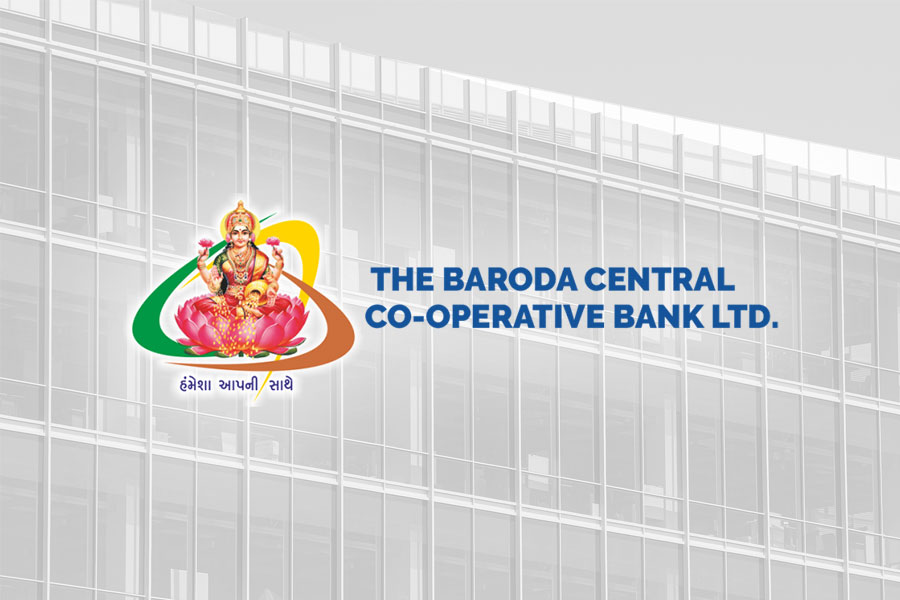 Baroda Central Co Operative Bank IFSC Code and MICR Code
Baroda Central Co Operative Bank IFSC Code and MICR Code
Find Baroda Central Co Operative Bank IFSC Code, MICR Code and branch details for NEFT, RTGS & IMPS transactions.
 Baroda Central Co Operative Bank IFSC Code and MICR Code
Baroda Central Co Operative Bank IFSC Code and MICR CodeFind Baroda Central Co Operative Bank IFSC Code, MICR Code and branch details for NEFT, RTGS & IMPS transactions.
 Baroda Central Co Operative Bank IFSC Code Finder - Select Your State
Baroda Central Co Operative Bank IFSC Code Finder - Select Your StateThe Baroda Central Co-Operative Bank was formed in 1913. The bank is fully computerized and offers various online banking services. You’ll need to use the Baroda Central Co-Operative Bank IFSC Code to initiate wire transfers with the bank.
The Baroda Central Co-Operative Bank has thirty-seven branches plus an administrative office in Gujarat. The head office is located at Station Road, Sayajigunj, Vadodara. Many other branches are also located in the Vadodara district.
The Indian banking system uses IFSC, MICR, and SWIFT codes for various online transactions. The IFSC code is used for domestic money transfers through NEFT, RTGS, IMPS, etc. The MICR code is used for electronic cheque clearing, and the SWIFT code is meant for international transactions between two bank accounts.
In this article, we’ll read more about the banking codes and ways to find them online and offline. Let’s also find out how to use online funds transfer methods like NEFT, RTGS, and IMPS to make digital transactions.

The IFSC or Indian Financial System Code is a unique 11-character code allotted by the Reserve Bank of India (RBI) to each bank branch in the country. The IFSC code is to facilitate online money transfers between two domestic bank accounts.
The IFSC code contains three parts- the first four characters are the bank code. The character in the fifth place is always a zero (0). The remaining six characters are the branch code and can be alphabets, numbers, or a combination of both.
For example, the Baroda Central Co-Operative Bank Head Office Branch IFSC Code is GSCB0BRD001. It is located at Station Road, Sayajigunj, Vadodara. This code is divided as follows:
So what is the purpose of the IFSC code? The Indian banking system uses distinct codes to speed up digital transactions and eliminate discrepancies when transferring funds online through NEFT, RTGS, and IMPS. It helps identify the branch where the receiver’s (beneficiary) account is located to deposit the money.
What happens when you enter an incorrect IFSC code? If both accounts belong to the same branch, the transaction might still be successful, given you enter the correct account number. Entering the wrong account number and IFSC code will lead to the following results.
The transaction may fail if the system cannot find and match the details you provided with the ones in its database. The amount will be reverted to your account in a couple of working days.
However, if the account number matches another account, the amount will be credited to that account. You have to contact the branch immediately to reverse the transaction. That’s why it is crucial to find the correct IFSC code for the bank branch and use it for online fund transfers.
The MICR or Magnetic Ink, Character Recognition code is also allotted by the RBI to the bank branches in India. This 9-digit code is printed at the bottom of the cheques using MICR technology. It is used by the banking system to validate the authenticity of cheques during electronic clearing.
The Baroda Central Co-Operative Bank MICR Code is 390153004 for the head office branch in Sayajigunj, Vadodara. There are three parts to the MICR code:
While the IFSC code is used by customers to initiate online fund transfers, the MICR code is used by the banks to speed up cheque processing through ECS (Electronic Clearing System). The MICR code acts as a tool to authenticate the genuineness of the cheque. This code is not used by customers.
Furthermore, the MICR code is not allotted to all bank branches. Non-MICR branches follow manual cheque clearing, which takes time and effort.

Now that you know the importance of using the correct IFSC code for an online funds transfer, it’s time to learn to find it online and offline. Fortunately, the banking codes are easily accessible through different means.
The online methods can be used by anyone (sender or receiver), while the offline methods are more suitable for beneficiaries. The best part is that all methods are free and hassle-free. Let’s check out each method in detail.
An easy way to find the IFSC and MICR codes online is by accessing a free and reliable website like Find Your Bank. It is an efficient way to gather the available information about a bank branch. You can find the IFSC, MICR, and SWIFT (if applicable) codes of any branch in India.
Open the URL in your browser: https://findyourbank.in/
Use the form on the homepage to enter the name and location of the bank branch. The form has drop-down fields to simplify things. Note that the webpage will automatically reload after each selection.
The webpage will have the branch’s name, address, contact information, IFSC code, MICR code, and SWIFT code (if applicable). Copy and use the codes for your online fund transfers. Find Your Bank is also available as a free Mobile App for Android smartphones. From the Play Store, you can download it and use it whenever you like.
The chequebook is provided by the branch to account holders who request it. The IFSC and MICR codes are printed on the first page of the chequebook and on every cheque. The IFSC code is there at the top, beside the bank logo, and the MICR code is printed at the bottom beside the cheque number.
A passbook is used to record the financial transactions that happen in the account. Every account holder has a passbook. The first page of the passbook contains information about the branch and the account holder. The branch address, contact information, IFSC, and MICR codes are printed on the page.
Other information like the account holder’s name, address, account number, customer ID, etc., are also printed on the same page.
The bank’s official website and mobile app will have the IFSC codes of all branches for user convenience. Check out the bank’s digital platforms to find the codes easily.
As a last option, you can call the bank’s customer care and ask for the IFSC code of the branch with the beneficiary’s account. Account-holders and non-account holders can contact customer care. Don’t share confidential information like debit card details, passwords, or PINs.

Online money transfer methods are simple and convenient. You can use them to send money to any account at any time. NEFT, RTGS, IMPS, etc., are used for domestic transactions and require the bank’s IFSC code to facilitate the payment. We’ll discuss the three methods below to know more.
NEFT is one of the most used online fund transfer methods in the country. It runs on the DNS (Deferred Net Settlement) system, where the transactions are cleared in batches once every two hours. NEFT payments can be sent from net/ mobile banking platforms and bank branches but are irreversible.
It is a 24*7*365 service with no minimum or maximum limit on the transaction. Some banks may have a maximum limit when the transaction is made from the branch. NEFT payments can be sent any number of times to any domestic account. Each transaction has a service charge based on the amount sent.
The service charges range from Rs. 2.50 to Rs. 25 plus tax. Some banks off free NEFT services for net/ mobile banking users. You need the following details to initiate an NEFT payment:
RTGS is a secure payment system used to send money in real-time to any domestic bank account. In the event of a large transfer between accounts, it is a safe and secure method. People use RTGS to send high amounts during emergencies. RTGS transactions can also be sent from net/ mobile banking accounts and the branch.
The minimum limit for RTGS payment is Rs. 2 lakhs, and the maximum amount is Rs. 5 lakhs. The service charges are costlier than NEFT and can be between Rs. 25 and Rs. 49 plus tax. The RTGS payment system is maintained by the RBI to ensure hassle-free transactions.
You need the below documentation for RTGS transactions:
IMPS was first initiated by the National Payments Corporation of India (NPCI) in 2010. It used the registered mobile number of the account holder to initiate an online fund transfer. The amount can be transferred between two bank accounts or mobile numbers (within India).
You need to first register your mobile number with the branch and request the Mobile Money Identifier (MMID) to send money through IMPS. It is an instant payment method that works 24*7 and even on bank holidays. It can be sent through net/ mobile banking, SMS, ATMs, AADHAR, and bank branch.
The minimum limit for an IMPS transaction is Re. 1, and the maximum limit is Rs. 2 lakhs. The service charges vary based on the bank. However, banks cannot charge more than Rs.25 plus tax for a transaction. The following details are required for an IMPS payment.

The Baroda Central Co-Operative Bank was formed in 1913. It was registered under the Gujarat Co-operative Societies Act in 1950. The bank has thirty-seven branches in Gujarat and one administrative/ head office located in Station Road, Sayajigunj, Vadodara.
The bank has evolved over the years to offer several financial services to Oo-Operative societies, farming communities, and regular customers. The Baroda Central Co-Operative Bank has net banking and mobile banking facilities, apart from online bill payment services and tie-ups with third-party UPI apps.
The bank issues RuPay debit cards and RuPay Kisan Credit cards to its customers and has special programs to promote digital transactions and increase banking literacy in rural areas. All the bank’s branches are fully computerized.
The customer care number of Baroda Central Co-Operative Bank is (0265) 2362641 / 2362642.
No, it’s not. This is a nationalized bank and the third-largest in the country. The Baroda Central Co-Operative Bank is a co-Op bank registered under the Gujarat Co-Operative Societies Act.
Yes. The Baroda Central Co-Operative Bank accounts can be linked with third-party UPI apps like BHIM, Google Pay, PhonePe, etc. There is a transaction limit of Rs. 25,000 per day.